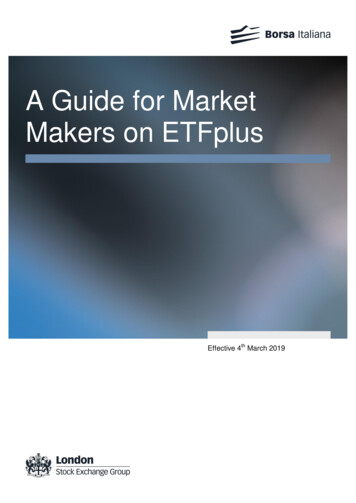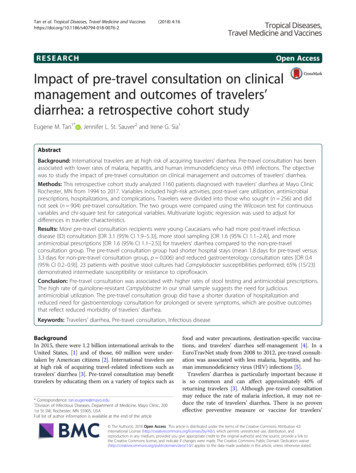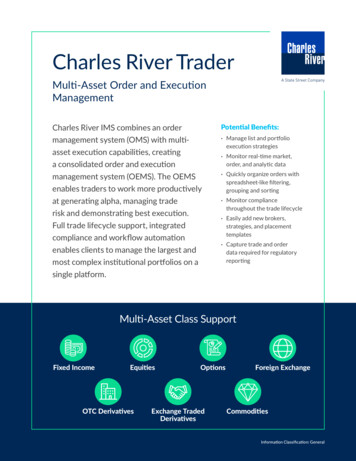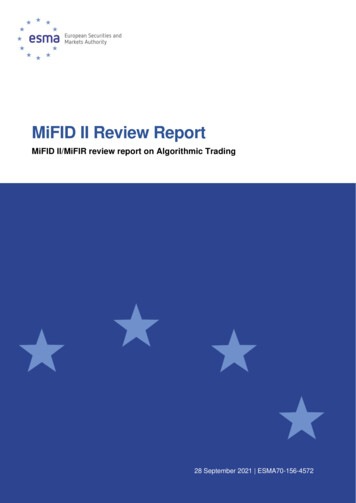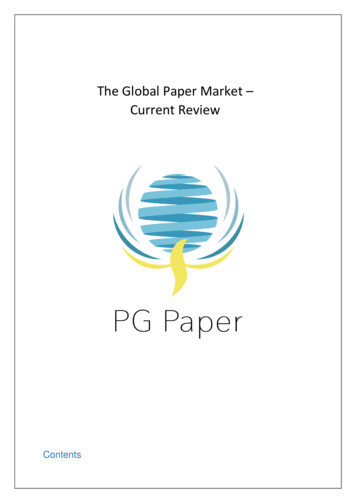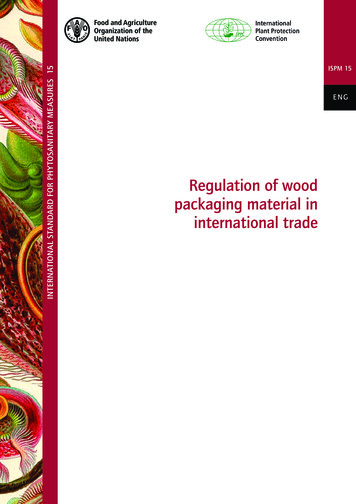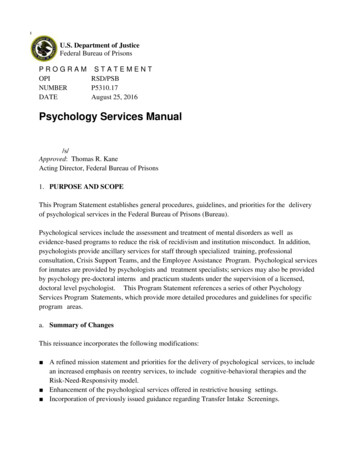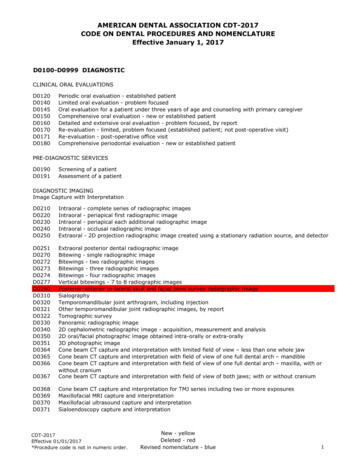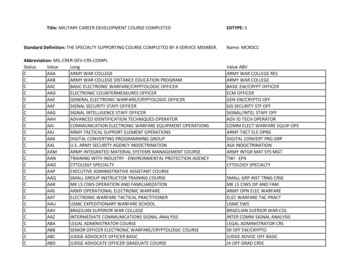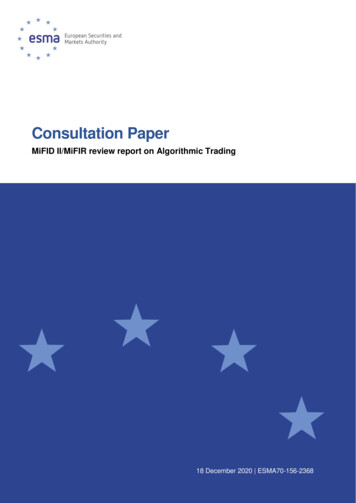
Transcription
Consultation PaperMiFID II/MiFIR review report on Algorithmic Trading18 December 2020 ESMA70-156-2368
18 December 2020ESMA70-156-2368Responding to this paperESMA invites comments on all matters in this paper and in particular on the specific questionssummarised in Annex 1. Comments are most helpful if they: respond to the question stated; indicate the specific question to which the comment relates; contain a clear rationale; and describe any alternatives ESMA should consider.ESMA will consider all comments received by 12 March 2021.All contributions should be submitted online at www.esma.europa.eu under the heading ‘Yourinput - Consultations’.Publication of responsesAll contributions received will be published following the close of the consultation, unless yourequest otherwise. Please clearly and prominently indicate in your submission any part you donot wish to be publicly disclosed. A standard confidentiality statement in an email message willnot be treated as a request for non-disclosure. A confidential response may be requested fromus in accordance with ESMA’s rules on access to documents. We may consult you if wereceive such a request. Any decision we make not to disclose the response is reviewable byESMA’s Board of Appeal and the European Ombudsman.Data protectionInformation on data protection can be found at www.esma.europa.eu under the heading LegalNotice.Who should read this paper?All interested stakeholders are invited to respond to this consultation paper. In particular,responses are sought from trading venues and from investment firms engaged in algorithmicand high-frequency trading activities.ESMA 201-203 rue de Bercy CS 80910 75589 Paris Cedex 12 France Tel. 33 (0) 1 58 36 43 21 www.esma.europa.eu2
Table of ContentsExecutive Summary .10Introduction .11Overall approach .123.1Legal framework.12Algorithmic trading .13High-frequency trading .14Direct Electronic Access (DEA) .153.2Analysis.16State of play of algorithmic trading, HFT and DEA .17Scope of Algorithmic trading.23High Frequency Trading .24Direct Electronic Access (DEA) .24Third-country firms .273.3Conclusions and proposals .29Scope of Algorithmic trading.29DEA .29Organisational requirements for investment firms .314.1Notifications to NCAs, exchange of information and on-going supervision .32Legal framework.32Assessment and proposals .334.2Application of RTS 6.35Legal framework.35Assessment and proposals .37Organisational requirements for trading venues .415.1Capacity and Resilience of Trading Venues .42Legal framework.42Assessment and proposals .435.2Testing of algorithms .45Legal framework.453
Assessment and proposals .465.3Circuit Breakers.48Legal framework.48Assessment and proposals .495.4Co-location and fee structure .52Legal framework.52Assessment and proposals .535.5Orders to Transactions Ratio (OTR) .55Legal framework.55Assessment and proposals .565.6Monitoring of compliance with trading venues’ rules .58Legal framework.58Assessment and proposals .59Tick size, market making, asymmetric speedbumps, and trade feeds .626.1Tick-size regime .62Legal framework.62Tick size regime applicable to shares .65Tick size regime applicable to third-country shares .67Tick size regime applicable to ETFs .71Tick size regime for non-equity instruments .726.2Market making agreements .73Legal framework.73Assessment of the regime .75Conclusions and proposals .806.3Speedbumps in Financial Markets.82Legal framework.83Analysis.85Assessment and proposals .886.4Asymmetry of private and public feeds .91Legal framework.92Assessment and proposals .92Annexes .964
7.1Annex I .967.2Annex II .1017.3Annex III .1025
Acronyms and definitions usedADNTAverage Daily Number of TransactionsAMFAutorité des Marchés FinanciersCDR (EU) 2017/565Commission Delegated Regulation (EU) 2017/565 of 25 April2016 supplementing Directive 2014/65/EU of the EuropeanParliament and of the Council as regards organisationalrequirements and operating conditions for investment firms anddefined terms for the purposes of that DirectiveCDR (EU) 2019/442Commission Delegated Regulation (EU) 2019/442 of 12December 2018 amending and correcting Delegated Regulation(EU) 2017/587 to specify the requirement for prices to reflectprevailing market conditions and to update and correct certainprovisionsCFTCCommodity Futures Trading CommissionCPConsultation PaperDanish FSADanish Financial Supervisory AuthorityDEADirect Electronic AccessECEuropean CommissionETCExchange Traded CommodityETFExchange Traded FundETNExchange Traded NoteEUEuropean UnionESMAEuropean Securities and Markets AuthorityFBAFrequent Batch AuctionFITRSFinancial Instruments Transparency SystemHFTHigh Frequency TradingIFRInvestment Firm ReviewLMELondon Metal ExchangeMARMarket Abuse Regulation – Regulation (EU) 596/2014 of theEuropean Parliament and of the CouncilMiFID IIMarkets in Financial Instruments Directive (recast) - Directive2014/65 of the European Parliament and of the Council6
MiFIRMarkets in Financial Instruments Regulation – Regulation600/2014 of the European Parliament and of the CouncilMRMTLMost Relevant Market in terms of LiquidityMTFMultilateral Trading FacilityNCANational Competent AuthorityOTCOver-the-counterOTFOrganised Trading FacilityOTROrder to Transaction RatioPOPPassive Order ProtectionQ&AQuestion and answerRCBReasonable Commercial BasisRTSRegulatory Technical StandardRTS 1Commission Delegated Regulation (EU) 2017/587 of 14 July ontransparency requirements for trading venues and investmentfirms in respect of shares, depositary receipts, exchange-tradedfunds, certificates and other similar financial instruments and ontransaction execution obligations in respect of certain shares ona trading venue or by a systematic internaliserRTS 6Commission Delegated Regulation (EU) 2017/589 of 19 July2016 on the organisational requirements of investment firmsengaged in algorithmic tradingRTS 7Commission Delegated Regulation (EU) 2017/584 of 14 July2016 supplementing Directive 2014/65/EU of the EuropeanParliament and of the Council with regard to regulatory technicalstandards specifying organisational requirements of tradingvenuesRTS 8Commission Delegated Regulation (EU) 2017/578 of 13 June2016 supplementing Directive 2014/65/EU of the EuropeanParliament and of the Council on markets in financial instrumentswith regard to regulatory technical standards specifying therequirements on market making agreements and schemesRTS 9Commission Delegated Regulation (EU) 2017/566 of 18 May2016 supplementing Directive 2014/65/EU of the EuropeanParliament and of the Council on markets in financial instrumentswith regard to regulatory technical standards for the ratio ofunexecuted orders to transactions in order to prevent disorderlytrading conditions7
RTS 10Commission Delegated Regulation (EU) 2017/573 of 6 June2016 supplementing Directive 2014/65/EU of the EuropeanParliament and of the Council on markets in financial instrumentswith regard to regulatory technical standards on requirements toensure fair and non-discriminatory co-location services and feestructuresRTS 11Commission Delegated Regulation (EU) 2017/588 of 14 July2016 supplementing Directive 2014/65/EU of the EuropeanParliament and of the Council with regard to regulatory technicalstandards on the tick size regime for shares, depositary receiptsand exchange-traded fundsSECUS Securities and Exchange CommissionSISystematic InternaliserTRV ReportTrends, Risks and Vulnerabilities ReportTVTrading venue8
9
Executive SummaryReasons for publicationDirective 2014/65/EU1 (MiFID II) and Regulation (EU) No 600/20142 (MiFIR) provide for anumber of review reports requiring the European Commission (EC), after consulting ESMA,to present reports to the European Parliament and the Council on various provisions. Thisconsultation paper (CP) covers the review provision on the impact of requirements regardingalgorithmic trading including high-frequency algorithmic trading set out under Article 90(1)(c)of MiFID II.ContentsMany provisions and requirements of MiFID II relate either directly or indirectly (e.g. directelectronic access or tick sizes) to algorithmic trading. This consultation paper thereforeadopts a holistic approach to algorithmic trading and reviews all related provisions togetherwith the aim of having the current framework operating more efficiently.Section 2 provides an introduction to the report. Section 3 presents an overall approachtowards algorithmic trading and high frequency trading and in particular the authorisationregime attached to these types of market participants, together with some quantitativeanalysis. Section 4 discusses the organisational requirements for investment firms thatengage in algorithmic trading, including high-frequency traders. Section 5 focusses on theorganisational requirements for trading venues that enable algorithmic trading on theirsystems.Finally, Section 6 addresses the other provisions that aim at better framing the activity ofalgorithmic and high-frequency traders such as tick sizes and market making, while alsodiscussing new issues which have recently emerged on EU markets and are very closelylinked to algorithmic trading, such as the deployment of mechanisms called speedbumpsand the sequence of trade confirmation to individual participants by trading venues versusthe public disclosure of such transactions.Next StepsESMA will consider the feedback it receives to this consultation and expects to publish afinal report and submit it to the European Commission by July 2021.10
IntroductionArticle 90 (1)(c) of MiFID II:Before 3 March 2020 the Commission shall, after consulting ESMA, present a report to theEuropean Parliament and the Council on:[ ](c)the impact of requirements regarding algorithmic trading including high-frequencyalgorithmic trading;[ ]1. MiFID II/MiFIR require the European Commission (EC) to present reports to the EuropeanParliament and the Council, after consulting ESMA, on a number of provisions. Article90(1)(c) of MiFID II provides in particular for the submission of a report on “the impact ofrequirements regarding algorithmic trading, including high-frequency algorithmic trading”.2. The MiFID II mandate is therefore not specific regarding which provisions should bereviewed in the concerned report. The concept of algorithmic trading is however broad,and many provisions and requirements of MiFID II are related either explicit to this typeof trading (e.g. Article 17 of MiFID II) or indirectly (e.g. Direct Electronic Access or ticksizes).3. In this consultation paper, ESMA has considered that it was necessary to adopt a holisticapproach and to review all relevant provisions together. The consultation paper thereforecovers (i) the overall approach towards algorithmic trading and high frequency tradingand in particular the authorisation regime attached to these types of market participants,(ii) the provisions applicable to algorithmic and high-frequency traders, (iii) the provisionsapplicable to trading venues allowing or enabling these market participants and (iv) otherprovisions that aim at better framing the activity of algorithmic and high-frequency traders(e.g. tick size and market making).4. ESMA has also considered it necessary to include sections on new issues which haverecently emerged in EU markets and that are very closely linked to algorithmic trading,1Directive 2014/65/EU of the European Parliament and of the Council of 15 May 2014 on markets in financial instruments andamending Directive 2002/92/EC and Directive 2011/61/EU (OJ L 173, 12.6.2014, p. 349–496).2Regulation (EU) No 600/2014 of the European Parliament and of the Council of 15 May 2014 on markets in financial instrumentsand amending Regulation (EU) No 648/2012 (OJ L 173, 12.6.2014, p. 84).11
i.e. the recent deployment of mechanisms called speedbumps and the issue about thesequence of publication between (i) the order/trade confirmations sent to individualparticipants and (ii) the public disclosure of orders and transactions.5. Article 90(1)(c) of MiFID II requires the Commission to present its report by 3 March 2020.However, a series of unexpected events have forced ESMA and the Commission toreconsider this deadline. In particular, Brexit and the covid-19 crisis have not only shiftedthe order of priorities for EU regulators, but this has also forced EU27 markets to adjustquickly to this new reality making the analysis of the impact of MiFID II more challengingto undertake in practice.6. Based on the responses received to this consultation, ESMA will prepare the final reviewreport for submission to the European Commission. Respondents to the consultation areencouraged to provide relevant information, including quantitative data, to support theirarguments or proposals. ESMA will endeavours to submit its review report to theCommission by June 2021.Overall approach7. This section provides an overall approach to algorithmic trading, including high-frequencytrading (HFT), under MiFID II. It first sets out the legal framework governing this activityin Level 1. The section then provides an overview of firms conducting algorithmic tradingincluding High Frequency Trading (HFT) in the EU. It further discusses two issues thathave arisen regarding the scope of application of MiFID II algorithmic trading and HFTrules in relation to Direct Electronic Access (DEA) and third-country firms. A summary ofrules applicable to HFT in some third-country jurisdictions is provided in Annex III-C.3.1 Legal framework8. As part of its objective of having more efficient and resilient markets, MiFID II seeks tokeep pace with technological developments. Whilst recognising the benefit of new tradingtechnologies, MiFID II also aims at addressing the potential risks from increased use oftechnology, including algorithmic trading, HFT or DEA. As explained in Recital (63) ofMiFID II, “Those potential risks from increased use of technology are best mitigated by acombination of measures and specific risk controls directed at firms that engage inalgorithmic trading or high-frequency algorithmic trading techniques, those that providedirect electronic access, and other measures directed at operators of trading venues thatare accessed by such firms”.12
Algorithmic trading9. Under Article 4(1)(39) of MiFID II, algorithmic trading is defined as “trading in financialinstruments where a computer algorithm automatically determines individual parametersof orders such as whether to initiate the order, the timing, price or quantity of the order orhow to manage the order after its submission, with limited or no human intervention, anddoes not include any system that is only used for the purpose of routing orders to one ormore trading venues or for the processing of orders involving no determination of anytrading parameters or for the confirmation of orders or the post-trade processing ofexecuted transactions”.10. The definition is further specified in Article 18 of Commission Delegated Regulation (EU)2017/5653 which sets out that “[ ] a system shall be considered as having no or limitedhuman intervention where, for any order or quote generation process or any process tooptimise order-execution, an automated system makes decisions at any of the stages ofinitiating, generating, routing or executing orders or quotes according to pre-determinedparameters”.11. In response to questions from stakeholders, ESMA also issued Q&As4 to clarify the scopeof the computer algorithms captured by the MiFID II definition, notably that the use ofalgorithms which only serve to inform a trader of a particular investment opportunity is notconsidered as algorithmic trading, provided that the execution is not algorithmic.12. An investment firm 5 that uses algorithmic trading is required to comply with specificrequirements to identify and mitigate the risks associated with this type of trading. Thoserequirements include in particular:-Notification to the NCA of the Home Member State and to the NCAs of the tradingvenues where it deploys its algorithmic trading strategies;-Provision of information upon request about its trading algorithms, systems andcontrols to its Home Member State NCA. The Home Member State NCA mayshare this information with the NCAs of the trading venues where the investmentfirm deploys its strategies; and-Compliance with organisational requirements, as discussed in section 4.3Commission Delegated Regulation (EU) 2017/565 of 25 April 2016 supplementing Directive 2014/65/EU of the EuropeanParliament and of the Council as regards organisational requirements and operating conditions for investment firms and definedterms for the purposes of that Directive (OJ L 87, 31.3.2017, p. 1–83).4See for instance questions 1 to 3 of section 3 of the MiFID II/MiFIR Q&As on market structure les/library/esma70-872942901-38 qas markets structures issues.pdf).5Those requirements also apply to members or participants of regulated markets and MTFs who are not required to be authorisedunder MiFID II pursuant to points (a), (e), (i) and (j) of Article 2(1).13
13. Likewise, a trading venue that allows algorithmic trading through its system must complywith specific obligations that are set out in section 5.14. However, and in contrast to HFT, the mere use of algorithmic trading techniques otherthan HFT does not trigger the requirement for that person to be authorised as aninvestment firm.High-frequency trading15. High-frequency trading is a sub-set of algorithmic trading. Article 4(1)(40) of MiFID IIdefines high frequency algorithmic trading technique as “an algorithmic trading techniquecharacterised by:(a) infrastructure intended to minimise network and other types of latencies, includingat least one of the following facilities for algorithmic order entry: co-location, proximityhosting or high-speed direct electronic access;(b) system-determination of order initiation, generation, routing or execution withouthuman intervention for individual trades or orders; and(c) high message intraday rates which constitute orders, quotes or cancellations.”16. Article 19 of Commission Delegated Regulation (EU) 2017/565 further defines a “highmessage intraday rate” as the submission on average of any of the following:“(a) at least 2 messages per second with respect to any single financial instrumenttraded on a trading venue;(b) at least 4 messages per second with respect to all financial instruments traded ona trading venue”;where only messages concerning financial instruments for which there is a liquid marketare to be included in the calculation.17. Where a firm is using a high-frequency algorithmic trading technique, the exemption fromauthorisation as an investment firm when only dealing on own account under Article2(1)(d) of MiFID II is no longer available. Nor are the exemptions under Article 2(1)(e) ofMiFID II for operators dealing on own account in emission allowances and Article 2(1)(j)of MiFID II for commodity firms. The required authorisation aims at ensuring that thosefirms are subject to organisational requirements under MiFID II and that they are properlysupervised. Firms that are exempted from MiFID II under points (a), (e), (i) and (j) ofArticle 2(1) of MiFID II and that use algorithmic trading techniques are not required to be14
authorised as investment firm but are subject to the measures and controls aiming totackle the specific risks arising from algorithmic trading.18. In addition to the requirements applicable to firms engaged in algorithmic trading, firmsusing high-frequency algorithmic trading techniques are subject to specific record keepingrequirements that are discussed in section 4.Direct Electronic Access (DEA)19. A further concept important to note in the context of trading technology is Direct ElectronicAccess (DEA). Under Article 1(41) of MiFID II, DEA refers to “an arrangement where amember or participant or client of a trading venue permits a person to use its trading codeso the person can electronically transmit orders relating to a financial instrument directlyto the trading venue and includes arrangements which involve the use by a person of theinfrastructure of the member or person or client or any connecting system provided bythe member or participant or client, to transmit the orders (direct market access or DMA)and arrangements where such an infrastructure is not used by a person (sponsoredaccess)”.20. Article 21(4) of Commission Delegated Regulation (EU) 2017/589 6 (RTS 6) furtherintroduces the concept of sub-delegation by referring to: “A DEA provider allowing aDEA client to provide its DEA access to its own clients ('sub-delegation') [ ]”.21. When a person accesses a trading venue using DEA, the exemption from authorisationas investment firm for persons only dealing on own account under Article 2(d) of MiFID IIis no longer available to that person.22. DEA providers must be authorised as investment firms or credit institutions under Article48(7) of MiFID II and cannot operate under the equivalence regime for third-country firms.Furthermore, DEA providers must comply with additional organisational requirements.FIGURE 1: AUTHORISATION REQUIREMENTS FOR DEA USERS6Commission Delegated Regulation (EU) 2017/589 of 19 July 2016 supplementing Directive 2014/65/EU of the EuropeanParliament and of the Council with regard to regulatory technical standards specifying the organisational requirements ofinvestment firms engaged in algorithmic trading (OJ L 77, 20.3.2019, p. 417-448).15
Source: ESMA.3.2 Analysis23. Financial markets have significantly evolved over the past decade as a consequence ofnew technologies. Many market participants now make use of algorithmic trading wherea computer algorithm automatically determines aspects of an order with minimal or nohuman intervention and algorithmic trading continues to expand across asset classesfrom the more mature equity and interest rate markets to commodity markets. This hasled to significant changes in market structures and microstructures and has required toadapt EU legislation to this new paradigm.24. The impact of algorithms used for routing and executing trades in financial instrumentshas been one of the most discussed topics in the financial industry for some time. As setout in Recital (62) of MiFID II, “trading technology has provided benefits to the market andto market participants generally such as wider participation in markets, increased liquidity,narrower spreads, reduced short term volatility and the means to obtain better executionfor clients”. However, Recital (62) of MiFID II notes that trading technology also gives riseto a number of potential risks such as an increased risk of the overloading of the systemsof trading venues due to large volumes of orders, risks of algorithmic trading generatingduplicative or erroneous orders or otherwise malfunctioning in a way that may create adisorderly market, risk of overreaction to market events exacerbating volatility and risk ofmarket abuse behaviours. Through Level 1 and Level 2, MiFID II aims at mitigating therisks identified arising from algorithmic trading or high-frequency algorithmic tradingtechniques.Q1: What is your overall assessment of the MiFID II framework for algorithmic trading,HFT and DEA?16
Q2: In your views, are there risks other than the one mentioned in MiFID II or impactson market structure developments due to market electronification/ algorithmic tradingthat would deserve further regulatory attention? Please elaborate.State of play of algorithmic trading, HFT and DEA25. ESMA conducted a fact-finding exercise with NCAs and trading venues to try to assessthe prevalence of algorithmic trading, HFT and DEA. This section first considers thenotifications received by NCAs for such activities and then analyses recent trends in thedevelopment of algorithmic trading and HFT.3.2.1.1 Authorisations and notifications26. Based on the responses received from NCAs, no person has been authorised as aninvestment firm solely for applying an HFT technique when dealing on own account andtherefore, not being eligible to the exemptions under Articles 2(1)(d)(iii), 2(1)(e) and 2(1)(j)of MiFID II. This does not come as a surprise as a person applying an HFT technique canreasonably be expected to be either a direct member or participant of a trading venue orhave DEA to a trading venue to reduce latency and preserve the confidentiality of thealgorithms used. That person would therefore be authorised as an investment firm underArticle 5(1) of MiFID II in the first place. Although some firms using HFT techniques alsoexecute client orders, in which case they would need to seek authorisation on t
algorithmic trading including high-frequency algorithmic trading set out under Article 90(1)(c) of MiFID II. Contents Many provisions and requirements of MiFID II relate either directly or indirectly (e.g. direct electronic access or tick sizes) to algorithmic trading
